Just like in modern population, early medieval people wore mittens and gloves for various reasons. In this article, we will show how these mittens and gloves looked and what was their possible function.
By material
Leather
This material section contains leather and fur mittens and gloves.
- Leather mittens and gloves
Mittens and gloves made of leather protect against cold, heat and bruises. They can also fulfil an aesthetical function as they adhere to the body well. Four finds come from the 7th century. Grave No. 17 in Oberflacht, Germany contained „a strange pair of mittens with thick folds on the back and underlined with soft, almost ruined fabric“ (Dürrich – Menzel 1847: 11). A very similar example, made of a fine leather lined with linen, was found in the rich grave from Greding, Bavaria (Mord im Mittelalter 2012). The third example is a mitten decorated with an intertwined application from the boy’s grave from Cologne Cathedral, Germany (Gillich et al. 2008: 8-11). The fourth mitten is a fragment of goatskin decorated with an intertwined application from the grave no. 8 in St. Ulrich’s and St. Afra’s Abbey, Augsburg (Werner 1977: 163). Danish Hjørring Museum contains fragments of presumable mittens from the Viking Age made of lambskin, which were preserved probably thanks to being stored in a bronze vessel. Yet another leather example comes from an 11th century layer from Wrocław-Old Town (Turnau 1983: 25). Next suitable material comes from the Caucasus and Republic El Mari. A fantastic pair of mittens was discovered in the grave 13 from the site of Povetluzhye (Chalikov – Bezuchova 1960: Рис. 43). A fingerglove from Moščevaja Balka, which probably belonged to a woman due to its size and is made of soft lambskin, is decorated by sewn-on ribbons and red morocco leather circles on the knuckles (Jerusalimskaja 2012: 212, Пл. 130). Fingertips of this glove seem to be open so the last phalanxes were bare. Another Caucasian mittens from the period of 8th to 10th century are located in Metropolitan Museum, New York (Kajitani 2001: 90, Fig. 8). These mittens also leave phalanxes bare.If we looked into the Middle Ages in Europe, we would find a solid tradition of leather mittens described as „work mittens“ in archeological literature (Dahlbäck 1983: Fig. 201, Fig. 202; Williemsen 2015: 8–11). We can find these in the areas of present Denmark (Svendborg), Germany (Lübeck, Schleswig), Netherlands, Norway (i.e. Trondheim), Poland (Wrocław), Russia (Pskov, Novgorod), Sweden (Stockholm) and Great Britain (London) (Schnack 1998: 74–78; Williemsen 2015 and the Unimus catalogue). Medieval leather mittens were typically made of lambskin and cow leather (Mould et al. 2003: 3222; Williemsen 2015: 12).
Presumable fragments of leather mitten, find and reconstruction.
Museum of Hjørring, photographed by Elin Sonja Petersen.
11th century mitten from Wrocław-Old Town. Turnau 1983: 25.
Fragments of leather mitten made of fine leather lined with linen.
Rich grave from Greding, Bavaria, around 700 AD. Mord im Mittelalter 2012.
Leather mitten decorated with an application, Cologne Cathedral.
Gillich et al. 2008: 10.
A fragment of goatskin mitten decorated with an application. Grave no. 8 in St. Ulrich’s and St. Afra’s Abbey, Augsburg.
Martin 1988: Abb. 5; Peek – Nowak-Böck 2016: Abb. 28-29; Gillich et al. 2008: 12-13.
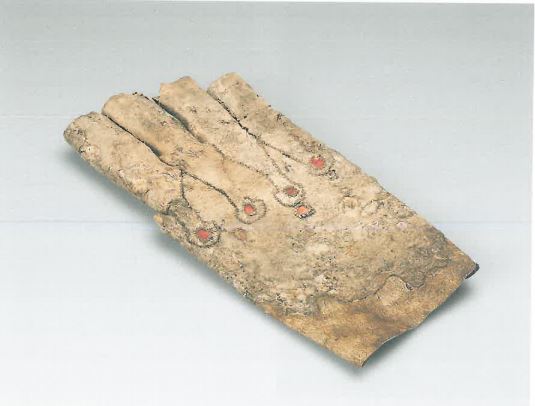

Leather mittens from Northern Caucasus.
Source: Jerusalimskaja 2012: Пл. 130; Orfinskaja 2001: Рис. 2.11.
Caucasian leather mittens (Kajitani 2001: 90, Fig. 8).
Leather gloves from the grave 13 of Povetluzhye (Chalikov – Bezuchova 1960: Рис. 43).
- Fur mittens
Mittens made of fur with hair inside seem to have a practical sense especially against coldness. Right hand mitten from Old Ladoga made of sheepskin in 8-9th century (Ojateva 1965: 50, Рис. 3 : 1; Orfinskaja – Michailov 2020: 115-6) can be mentioned among early medieval finds. Traces of fur mittens are known from several Finnish sites (Luistari, Vilusenharju, Kekomäki) and are made of deer, hare, sheep an foxskin (Kirkinen 2019: 66). A fragment of leather mitten with potential hair inside is known in the grave 6 of Rusenichinskij cemetery (Nikitina 2018: Рис. 23: 11). In the Saga of Eiríkr the Red (3), there is a seer who wears „mittens of cat fur with white hair inside“.
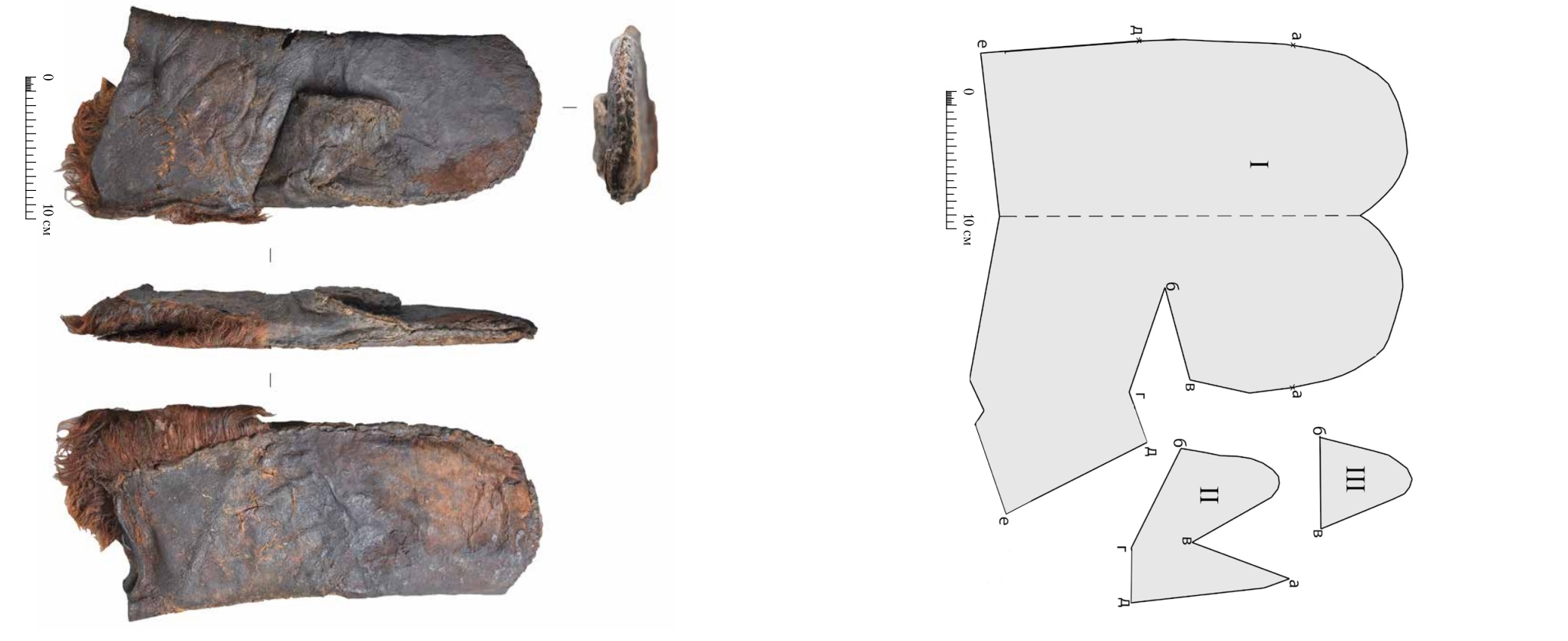 Mitten made of sheepskin, Old Ladoga, 8th–9th century.
Mitten made of sheepskin, Old Ladoga, 8th–9th century.
Orfinskaja – Michailov 2020: 115-6.
Wool
Mittens made of wool were among the most popular ones. Methods of their manufacture could differ.
- Felt mittens
Felting is a method of weaving fibers of wetted woven fabric in order to make a hardier, rain-proof textile. Two pieces which can be related to felt mittens can be found in the literature. One is the fingerless mitten from Dorestad, Netherlands (7th–10th century), which is made of two pieces of brown dyed, felted wool fabric originally sewn from herringbone textile (Brandenburgh 2010: 69; Miedema 1980: 250–254). Simple rectangular cover is thickened by a sewn-on square on the palm side. Brown felt fragment, perhaps originally belonging to a nålebound mitten, was found inside a grave in Finnish Halikko Rikala location and is dated to the 11th century (Vajanto 2014: 24–25). Felt mittens were used also in medieval Netherlands (Williemsen 2015: 4–5).
Simple two-pieced mitten from Dorestad.
Miedema 1980: Pl. 24, Fig. 174.
- Nålebound mittens
Mittens made by nålbinding technique were apparently popular in early Middle Ages, as shown by their geographic and chronological spread (Vajanto 2014: 22; Walton 1989: 341–345). That was because of their flexibility and sturdiness, which were essential especially in case of socks and mittens. Factual evidence comes from Iceland, Russia, Sweden, Norway and Finland. The Icelandic mitten was found in the ruins of Arnheiðarstaðir farmstead together with a bronze ringed-pin dated to 10th cenutry (Hald 1951). The Russian example comes from Yaroslavl and dates to 11th-12th century (Jakovčik 2020). The same dating is suggested for the mittens from Lödöse and Oslo mittens (Claßen-Büttner 2015: 46). Nålebound fragments were found in at least five Finnish, mostly women’s graves from 11th century (Eura Luistari 56, Halikko Rikala 38, Kaarina Kirkkomäki 31, Köyliö Köyliönsaari 28, Masku Humikkala 30) near the hands, which suggests that the body was put into the grave wearing mittens (Vajanto 2014: 25). Such fragments were often striped or embroidered; in case of the striped variants it was a combination of dark and light thread or a combination of blue, white and red shades (Vajanto 2014: 25–26). In case of the Finnish mittens, it is presumed that protection against cold was not their primary function as some burials occured in other seasons than winter, some dyes were not amongst the standardly used ones and the fragments did not imply using thumbs (Vajanto 2014: 30). A kind of knitted gloves or mittens of unknown material were found in the grave of Emperor Henry III, who died in 1056 (Herget 2011: 89, 135).
Mitten found in the ruins of Arnheiðarstaðir farmstead.
Hald 1951: 1. mynd.
The mitten from Yaroslavl, Russia. Source: Jakovčik 2020: Рис. 6.
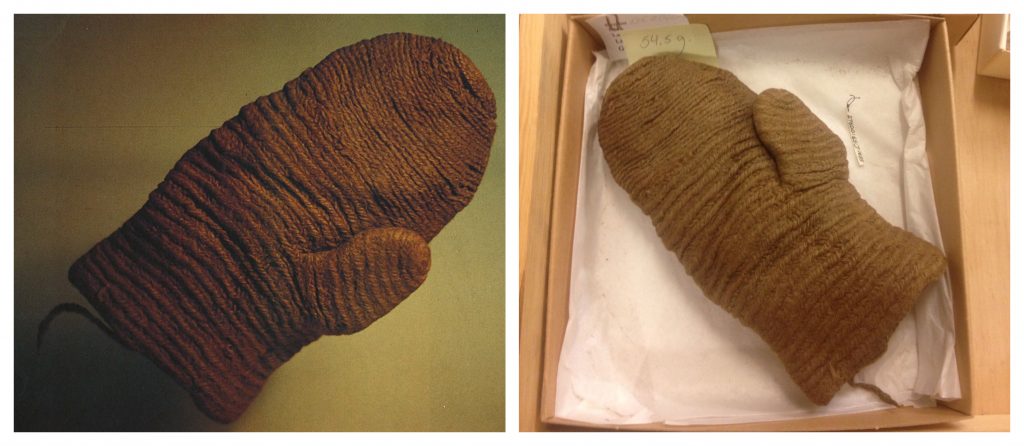
The mitten from Lödöse, Sweden. Source: Lödöse museum.
The mitten from Oslo, Norway. Source: Claßen-Büttner 2015: Fig. 37.
Presumable fragment of a mitten and its possible reconstruction.
Vajanto 2014: Figs. 2, 6, 7.
- Mittens sewn from a woven fabric
Mittens which were cut and sewn from a woven fabric with no underlining were probably the most frequently used of all. We will begin with the Icelandic ones. In the year 1881, in the place of former farmstead of Garðar on Akranes, a mitten was found that could be dated to the farmstead’s origin, which means 9-10th century (Pálsson 1895: 34–35). The mitten is four-pieced – front and back part, sewn-in thumb and an inset – left-handed and assuming from its wrist width, it was worn over upper clothing. It is interesting that the manufacturer used 2/2 twill with inwoven pile of unspun short tufts of brushed wool for the mitten, with the tufts functioning as an isolation (Guðjónsson 1962: 21–22). The remaining two Icelandic mittens were found together and therefore present the only preserved pair. They were found on Heynes in 1960 (Guðjónsson 1962: 16) and are dated to to the second half of the 10th century. These are evidently children’s mittens and they are connected with a sewn-on lace that could be threaded through sleeves, so the child would not lose them. These were probably made from re-used material which originally had a different function (Guðjónsson 1962: 30). The mittens are therefore unlike: right one is made of three pieces (main frame and two opposite pieces for the thumb), while the left one is four-pieced (two opposite pieces for the frame and two opposite pieces for the thumb). Thumb holes are not on the edge, instead they are placed with certain spacing. Another mitten made of rough woven wool was found in Foula, Shetlands during peat extraction in the 1950s (Christiansen 2024; Vikings 2012). It was carbon-dated to 975 and is made from 2/2 twill yarns in three different colours. A woolen mitten dated to 750-865 was found in Old Ladoga (Orfinskaja – Michailov 2020: 179-182). A presumably left-handed mitten was found in 2011 on the melting Lendbreen iceberg in Norway, conservatively estimated to be from the years 800–1000. It seems that this mitten was composed of at least four pieces: back, thumb and two-pieced palm. Another complete mitten is known from Norway, which comes from Trondheim and was found in the 1970s (Unimus 2024). It is a left mitten made of 2/2 twill and is dated to the period 1050-1150. One German mitten was found in Ralswiek and it is dated to 8th–9th century (Herrmann 1985: 288, Abb. 136). This one has a seam alongside its whole length and its wrist collar presents a standalone piece. The second German glove or mitten comes from the grave no. 58 in Trossingen, 6th century; the glove was made of red, yellow and black fabric that was decorated with an intertwined leather application and a reinforced leather thumb (Peek – Nowak-Böck 2016: 385-390). We should also mention the presumably right-handed mitten from Aalsum, Netherlands, which is dated to 8–10th century. The only known detail we have is that the warp threads are of average or small width and therefore density, while the weft threads are very thick and therefore have a low density per square centimeter. This solution, probably aiming to save material, can be also seen in cases of mittens from Garðar and Shetlands. Moreover, the mitten from Aalsum was also sewn together with a very thick thread. As far as we know, there is one written evidence of feather mitten from the early Middle Ages. It can be found in Haraldskvæði(verse 6) by Þorbjǫrn hornklofi, where it can be read that the ruler Haraldr Fairhair wore mittens stuffed with downy feathers – probably of an eider – in his youth (or child years). This verse compared a matured man willing to sail and fight even in winter and a spoiled boy who rather spends the winter in women’s part of the palace and wears feather mittens on his hands. From the context of this mitten we can perceive it as pertaining to a wealthy child’s apparel.
Mitten from Garðar, Iceland. Photography by dolbex.
Pair of mittens Heynes, Iceland.
Photography taken from Sarpur.is.
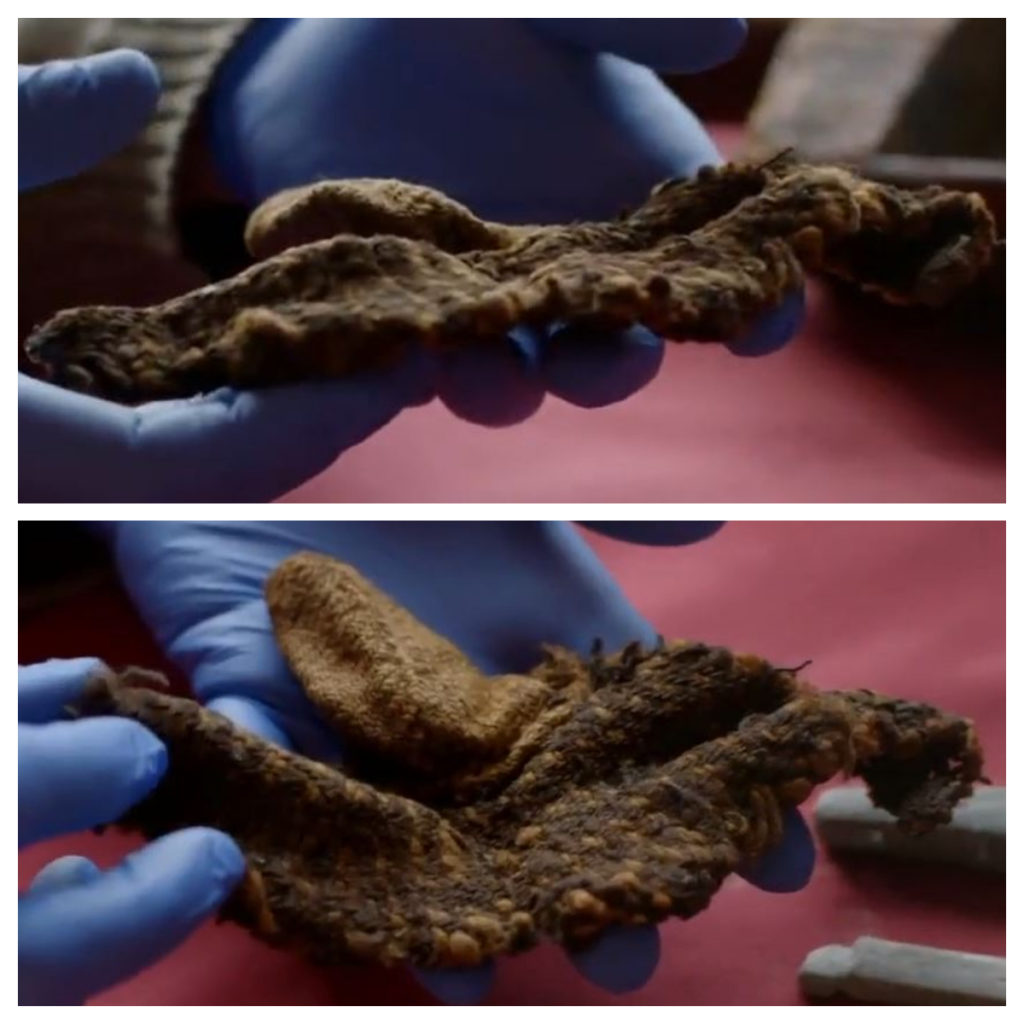
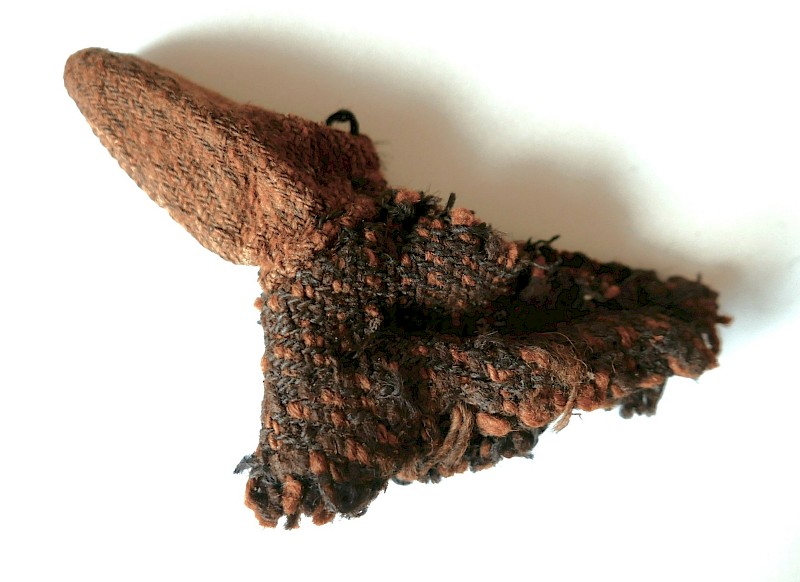
Mitten from Foula, Shetland Islands. Christiansen 2024; Vikings 2012.
Mitten from the Lendbreen iceberg in Norway.
Photos taken from Unimus.no catalogue.

Mitten from Trondheim. Photos taken from Unimus.no catalogue.
Woolen mitten from Ralswiek (Herrmann 1985: 288, Abb. 136).
Possible look of the glove / mitten from the grave no. 58, Trossingen, 6th century.
Peek – Nowak-Böck 2016: Abb. 26.
Mitten from Aalsum, Netherlands. Brandenburgh 2010: Fig. 22.
Woolen mitten, Old Ladoga.
Orfinskaja – Michailov 2020: 179-180.
Linen and silk
Linen gloves and mittens are not common objects. The only ones we currently have on record come from the Northern Caucasus and are both finger and fingerless, corresponding in shape to the leather variants used in the same region, but made of plain weave (Orfinskaja 2001: 43, Рис. 2.11). We admit the possibility that ecclesiastical gloves and mittens could have been used in the Early Middle Ages that were made of fine textiles (Müller 2003: 90, 133-4).


Plain weave Caucasian gloves and mittens. Orfinskaja 2001: Рис. 2.11 a 2.12.
Metal
Early Middle Ages provide us with only decent traces of iron mail being used as a hand protection. The first group of finds consists of protection represented by mail. The most important find of this kind comes from grave Valsgärde 8, Sweden, which contained guards or bracers for both legs and one hand, originally misinterpreted as chestplate (Arwidsson 1939; Arwidsson 1954). Vike (2000) believes that the mail was attached directly to the bracer, but Blaine (2024) is of the opinion that the mail was separate from the bracer and was attached to the mittens. We know this method from at least eleven other sites of the 7th-8th century: Castel Trosino, Szegvár-Oromdűlő, Szentes-Lapistó, Unirea-Vereşmort, Syvashivka, Lesnoe, Matyukhin Bugor, Klin-Yar, Sadon, Kievskoe and Amlash (Blaine 2024: Fig. 16; Beatson 2011–12; Kazdajeva – Malašev 2020). The find of a potential lamellar and scaly, 45 cm long glove with a forearm protector from grave 80 in the Avar locality Kölked-Feketekapu B (Rácz 2014: 169, Taf. 40-1) belongs to the 7th century. The discovery of a potential lamellar and scale 45 cm long glove with a bracer from grave 80 in the Avar locality Kölked-Feketekapu B (Rácz 2014: 169, Taf. 40-1) belongs to the 7th century. The forearm bracerts are visible on the treasure vase from the Nagyszentmiklós site (eg László – Rácz 1977: 2. kép). The second main group consists of lamellae covering the upper part of the hand, which can be found in three localities. The first find comes from a Lombardic tomb in the Italian locality of Sovizzo. The second find was revealed in the Roman workshop of Crypta Balbi, in which lamellae made of gilded bronze and iron were found, probably coming from two gloves. Both of these Lombardic finds from Italy protected the back of the hand and were placed parallel to the hand, not vertically, which explains the constant length of the lamellae around 12-13 cm. The third lamellar find comes from the Dutch locality of Lent and differs from previous pieces in that they are not constant lengths, so it is possible that they protected fingertips. If we extended our search beyond Europe or the early Middle Ages, we could, for example, find segmented gloves used in Italy (3rd century) or today’s Iran (7th century).
Probable reconstruction of limb protection from Valsgärde 8.
Property of Matt Bunker.
The find from grave 80 from Kölked-Feketekapu B. Source: Rácz 2014: Taf. 40-1.
A fragment of iron mail from grave no. 119 in Castel Trosino, Italy.
Cristiano Da Mont’Olmo Carassai.
Lamellae from the Lombardic grave from Sovizzo, Italy, and their reconstruction.
Source: Helvargar.
Lamellae from the Roman locality of Crypta Balbi, 7th century. Gilded bronze and iron.
Source: www.fotosar.it.
Fragments of a lamellar glove from the Dutch locality of Lent.
Source: Evan Schultheis.
By shape
According to the information we have, we can divide mittens and gloves by shape:
- Fingerless mittens (warmers)
Simple fingerless warmers fulfiling the function of mittens were documented in the area of present Netherlands, specifically the felt mitten from Dorestad. Fingerless form is speculated also in case of Finnish nålebound mittens, which were preserved without thumbs, however this could be a coincidence. We encountered no medieval analogy to this find. That is probably because this was a very primitive and impractical manner of hand protection.
- Mittens
Variously constructed mitten seems to be the most common early medieval shape and is continued until today. We assume it to occur in leather, textile and even metal variations. A mitten with its fingertips bare presents a specific variation known from the Caucasus. Norse myths also refer to mittens (related to the myth described in Gylfaginning 45).
- Finger gloves
Aside from the Trossingen, El Mari and Caucasian specimens we described earlier, it is supposed that finger gloves were not widespread in continental Europe until the 12th century. Even three finger gloves cannot be confirmed for the early Middle Ages despite their significant popularity in 14-16th century (Williemsen 2015: 18–20).
By function
As suggested before, gloves and mittens had multiple functions. Here is the outline:
- Protection against cold
The most presumed function is definitely protection against cold. Many mittens were undoubtedly intended to keep the hand warm and this aim was supported by additional protection – fur (Old Ladoga, Saga of Eiríkr the Red), inwoven tufts of wool (Garðar) or feathers (Haraldskvæði). We can assume that children’s mittens (Heynes, Haraldskvæði) were designated to keep their hands warm. One of the mittens (Lendbreen) was found on an iceberg with a popular tradition of reindeer hunting, which can be considered as an evidence of the mitten’s function. Moreover, a mitten was displayed on a 11th century runestone from the church in Sproge (G 373), Gotland, depicting a sleigh rider wearing mitten on his hand while driving horses (Snædal – Gustavson 2013: 43–48).
Horse-drawn sleigh on the runestone G 373 from Sproge, Gotland, 11th century.
Snædal – Gustavson 2013: 45.
- Working in cold and wet weather
It is logical that mittens were not only worn in wintertime during transport (horses, sleigh, ski, skates, ships). They were used while hunting, pulling ropes on a ship, fishing, tar making, plowing, herding, woodcutting, peat mining and other outdoor activities which could take place in bad weather.
- Blacksmithing
We could expect mittens being used while working at a forge. Nevertheless, this assumption is not confirmed; early medieval iconography depicts blacksmiths wearing no mittens nor gloves, sometimes also with their sleeves pulled up. The closest material can be found in a Norse myth referring to iron mittens enabling one to grab heated metal (Skáldskaparmál 26).
- Falconry
The noble art of falconry has often included wearing leather mittens, which provide better features against the bird’s grip. As far as we know, we have only two pieces of evidence for falconer’s mittens being used in early medieval Europe. The older one comes from a Byzantine mosaic inside so called Falconer’s Villa in Aros, Greece, which dates to the 6th century (Wallis 2017: Illus. 2). The newer source comes from an Anglo-Saxon cross in Bewcastle, England and is dated to 7-8th century (Wallis 2017: 430). In the rest of falconry scenes, for example on the Bayeux tapestry, people do not wear hand protection and have their birds of prey on bare hands (Owen-Crocker 2004: 265). Even skaldic kennings related to falconry do not mention hand protection. It is therefore legitimate to wonder if these cultural products reflect the reality trustworthily. Falconry scenes of 12th century and further periods already contain finger gloves (i.e. Schnack 1998: 48).
Mosaic inside the Falconer’s Villa. Argos, Greece, 6th century (Wallis 2017: Illus. 2).
Falconry scene on a cross in Bewcastle.
Taken from greatenglishchurches.co.uk.
- Protection in fight
Despite many historical parallels and common sense we are unable to prove other than rare use of protective hand protection during a fight. Mittens or gloves coated with iron mail present the only exceptions. As it seems, the absence of protection in sources is not caused by ravages of time, but instead by a different approach to this issue. The fighters apparently preferred fine motorics, were able to effectively block with their shields and in battle they mostly used a combination of shields and pole weapons. But most importantly, no kind of period protection could fully protect against all weapon types. The very same problem pertains also to archer’s gloves which could not be confirmed.
- Part of a spectacular clothing
Nevertheless, gloves and mittens could also fulfil an aesthetical function on the hands of wealthy and powerful. We saw they could be custom-made, painted, embroidered (Finnish mittens), decorated with expensive materials (Moščevaja Balka) or stuffed with deluxe padding (Haraldskvæði). They could therefore serve as a symbol of status to some extent, which is apparent especially in case of rulers and church representatives. We will mention two illustrative examples. Mittens are mentioned in the last will of Anglo-Saxon noble called Byrhtnoth, who leaves a „pair of skilfully crafted gloves“ (Owen-Crocker 2004: 265), and they also appear as a gift in the Saga of Njál (31), where the king bestows leather mittens embroidered with gold.
I hope you liked reading this article. If you have any question or remark, please contact me or leave a comment below. If you want to learn more and support my work, please, fund my project on Patreon or Paypal.
Bibliography
Sources
Gylfaginning = Gylfiho oblouzení. Přel. Helena Kadečková. In: Snorri Sturluson. Edda a Sága o Ynglinzích. Praha: Argo, 2003, 37–101.
Skáldskaparmál = Jazyk básnický. Přel. Helena Kadečková. In: Snorri Sturluson. Edda a Sága o Ynglinzích, Praha: Argo, 2003, 102–144.
Saga of Eiríkr the Red = Sága o Eiríkovi Zrzavém. Přel. Ladislav Heger. In: Staroislandské ságy, Praha, 1965: 15–34.
Saga of Njál = Sága o Njálovi. Přel. Ladislav Heger. In: Staroislandské ságy, Praha, 1965: 321–559.
Þorbjǫrn hornklofi : Haraldskvæði = Þorbjǫrn hornklofi : Haraldskvæði (Hrafnsmál), ed. R. D. Fulk. In: Skaldic poetry of the Scandinavian Middle Ages. Vol. 1, [Poetry from the kings’ sagas 1 : from mythical times to c. 1035], ed. Diana Whaley, Turnhout, 2012: 91–117.
Literature
Arwidsson 1939 = Arwidsson, Greta (1939). Armour of the Vendel period. In: Acta Archaeologica 10, København, 31–59.
Arwidsson 1954 = Arwidsson, Greta (1954). Valsgärde 8. Uppsala: Almqvist & Wiksells Boktryckeri.
Beatson 2011–12 = Beatson, Peter (2011–12). Armour in Byzantium in the early years of the Varangian Guard, with special reference to limb defenses. Available here.
Blaine 2024 = Blaine, Julian (2024). Faded Glory: Cultural exchange between warrior groups in the Vendel Period as reflected in armor from Vendel and Valsgärde, Uppsala.
Brandenburgh 2010 = Brandenburgh, Chrystel R. (2010). Early medieval textile remains from settlements in the Netherlands. An evaluation of textile production. In: Journal of Archaeology in the Low Countries 2/1, 41–79.
Claßen-Büttner 2015 = Claßen-Büttner, Ulrike (2015). Nalbinding- What in the World Is That? History and Technique of an Almost Forgotten Handicraft, Wiehl.
Dahlbäck 1983 = Dahlbäck, Göran (red.) (1983). Helgeandsholmen : 1000 år i Stockholms ström, Stockholm.
Dürrich – Menzel 1847 = Dürrich, Ferdinand von – Menzel, Wolfgang (1847). Die Heidengräber am Lupfen (bei Oberflacht), Stuttgart : Arnold.
Gillich et al. 2008 = Gillich, Antje – Peek, Christine – Planck, Dieter – Walter, Susanne (2008). Kleidung im frühen Mittelalter: Am liebsten schön bunt! (Porträt Archäologie), Esslingen am Neckar.
Guðjónsson 1962 = Guðjónsson, E.E. (1962). Forn röggvarvefnaður. In: Árbók Hins íslenzka fornleifafélags 1962, Reykjavík, 12–71.
Hald 1951 = Hald, Maragrethe (1951). Vötturinn frá Arnheiðarstöðum. In: Árbók Hins íslenzka fornleifafélags 1949–50, Reykjavík, 73–77.
Herget 2011 = Herget, Melanie (2011). Des Kaisers letzte Kleider. Neue Forschungen zu den organischen Funden aus der Herschergräbern im Dom zu Speyer, München.
Herrmann 1985 = Herrmann, Joachim (1985). Die Slawen in Deutschland. Geschichte und Kultur der slawischen Stämme westlich von Oder und Neisse vom VI. bis XII. Jahrhundert. Ein Handbuch, Berlin.
Chalikov – Bezuchova 1960 = Халиков, А. Х. – Безухова, Е. А. (1960). Материалы к древней истории Поветлужья, Горький.
Christiansen 2024 = Christiansen, Carol (2024). A Fragment of Viking-Norse Life. In: Shetland Museum & Archives [online]. [2024-01-24]. Available here.
Jakovčik 2020 = Яковчик, М. С. – Энговатова, А. В – Орфинская, О. В. – Чернова, О. Ф. (2020). Вязаная рукавица из раскопок в Ярославле // Археология Подмосковья. Материалы научного семирана, Вып. 16, 116-129.
Jerusalimskaja 2012 = Иерусалимская, А.А. (2012). Мощевая Балка. Необычный археологический памятник на Северокавказском шёлковом пути, СПб.
Kajitani 2001 = Kajitani, Nobuko (2001). A Man’s Caftan and Leggings from the North Caucasus of the Eight to Tenth Century: A Conservator’s Report. In: Metropolitan Museum Journal 36, 85–124.
Kadzajeva – Malašev 2020 = Кадзаева, З. П. – Малашев, В. Ю. (2020). О возможной атрибуции кольчужных предметов из воинских погребений Садонского могильника // История, археология и этнография Кавказа. Т. 16. № 4, 1016-1033.
Kirkinen 2019 = Kirkinen, Tuija (2019). Between skins. Animal skins in the Iron Age and historical burials in eastern Fennoscandia, Helsinki : University of Helsinki.
László – Rácz 1977 = László, Gyula – Rácz, István (1977). Der Goldschatz von Nagyszentmiklós, Budapest.
Martin 1988 = Martin, Max (1988). Bemerkungen zur frühmittelalterlichen Knochenschnalle eines Klerikergrabes der St. Verenakirche von Zurzach (Kt. Aargau). In: Jahrbuch der Schweizerischen Gesellschaft für Ur- und Frühgeschichte 71, 161–177
Miedema 1980 = Miedema, M. (1980). Textile finds from Dorestad, Hoogstraat I and II. In: W. A. van Es – W. J. H. Verwers (eds). Excavations at Dorestad I, The Harbour: Hoogstraat I, (Nederlandse Oudheden 9), Amersfoort, 250–261.
Mord im Mittelalter 2012 = Mord im Mittelalter – Das Fürstengrab von Greding (Hans Peter Kernstock, Germany, 2012), discussion with Britt Nowak-Böck, 0:12:54–0:17:19.
Mould et al. 2003 = Mould, Q., Carlisle, I, Cameron, E. (2003). Craft Industry and Everyday Life: Leather and Leatherworking in Anglo-Scandinavian and Medieval York. The small finds 17/16, York.
Müller 2003 = Müller, Mechthild (2003). Die Kleidung nach Quellen des frühen Mittelalters. Textilien und Mode von Karl dem Grossen bis Heinrich III., Berlin – New York.
Nikitina 2018 = Никитина Т. Б. (2018). Русенихинский могильник, Казань.
Ojateva 1965 = Оятева, Е.И. (1965). Обувь и другие кожаные изделия Земляного городища Старой Ладоги //Археологический сборник Государственного Эрмитажа, вып. 7, 42–59.
Orfinskaja 2001 = Орфинская, О. В. (2001). Текстиль VIII-IX вв. из коллекции Карачаево-Черкесского музея: технологические особенности в контексте культуры раннесредневековой Евразии, Москва.
Orfinskaja – Michailov 2020 = Орфинская, О. В. – Михайлов, К. А. (2020). Текстиль Старой Ладоги эпохи викингов, СПб.
Owen-Crocker 2004 = Owen-Crocker, Gale R. (2004). Dress in Anglo-Saxon England, Woodbridge : The Boydell Press.
Pálsson 1895 = Pálsson, Pálma (1895). Um myndir af gripum í forngripasafninu. In: Árbók Hins íslenzka fornleifafélags 1895, Reykjavík, 30–35.
Peek – Nowak-Böck 2016 = Peek, Christina – Nowak-Böck, Britt (2016). Die Untersuchungen an organischen Materialien des Grabes 58 von Trossingen (Lkr. Tuttlingen) – Vorbericht. In: Fundberichte aus Baden-Württemberg, Bd. 36, Esslingen am Neckar, 367-404.
Rácz 2014 = Rácz, Zsófia (2014). Die Goldschmiedegräber der Awarenzeit, Mainz.
Schnack 1998 = Schnack, Christiane (1998). Mittelalterliche Lederfunde aus Schleswig: Futterale, Riemen, Taschen und andere Objekte ; Ausgrabung Schild 1971–1975. Ausgrabungen in Schleswig Berichte und Studien 13, Neumünster.
Snædal – Gustavson 2013 = Snædal, Thorgunn – Gustavson, Helmer (2013). Supplement till Gotlands runinskrifter 1 : Sudertredingen : G 360 – G 386 samt tillägg till inskrifterna G 32, G 49, G 50, G 76, G 79, och G 104, Stockholm : Riksantikvarieämbetet. Available here.
Turnau, Irena (1983). Polskie skórnictwo, Wrocław.
Unimus 2024 = N30965 Klesplagg. In: UNIMUS Portalen [online]. [2024-01-24]. Available here.
Vajanto 2014 = Vajanto, Krista (2014). Nålbinding in Prehistoric Burials – Reinterpreting Finnish 11th–14th-century AD Textile Fragments. In: Janne Ikäheimo, Anna-Kaisa Salmi & Tiina Äikäs (eds.). Sounds Like Theory. XII Nordic Theoretical Archaeology Group Meeting in Oulu 25.–28.4.2012. Monographs of the Archaeological Society of Finland 2, 21–33.
Vike 2000 = Vike, Vegard (2000). Ring weave : A metallographical analysis of ring mail material at the Oldsaksamlingen in Oslo, Oslo [University thesis]. Available here.
Vikings 2012 = Vikings, episode 3 (Jon Eastman – Rosie Schellenburg – Simon Winchcombe, Great Britain, 2012), discussion of Niel Oliver with Dr. Ian Tait, 0:08:30–0:10:41.
Wallis 2017 = Wallis, R. J. (2017). “As the Falcon Her Bells” at Sutton Hoo? Falconry in Early Anglo-Saxon England. In: Archaeological Journal, 174 (2), 409–436.
Walton 1989 = Walton, Penelope (1989). Textiles, Cordage and Raw Fibre from 16-22 Coppergate. York Archaeological Trust: 17/05, London.
Werner 1977 = Werner, Joachim (Hrsg.) (1977). Die Ausgrabungen in St. Ulrich und Afra in Augsburg 1961-1968, Augsburg.
Williemsen 2015 = Williemsen, Annemarieke (2015). The Geoff Egan Memorial Lecture 2013 : Taking up the glove: finds, uses and meanings of gloves, mittens and gauntlets in western Europe, c. AD 1300–1700. In: Post-Medieval Archaeology 49/1, 1–36.












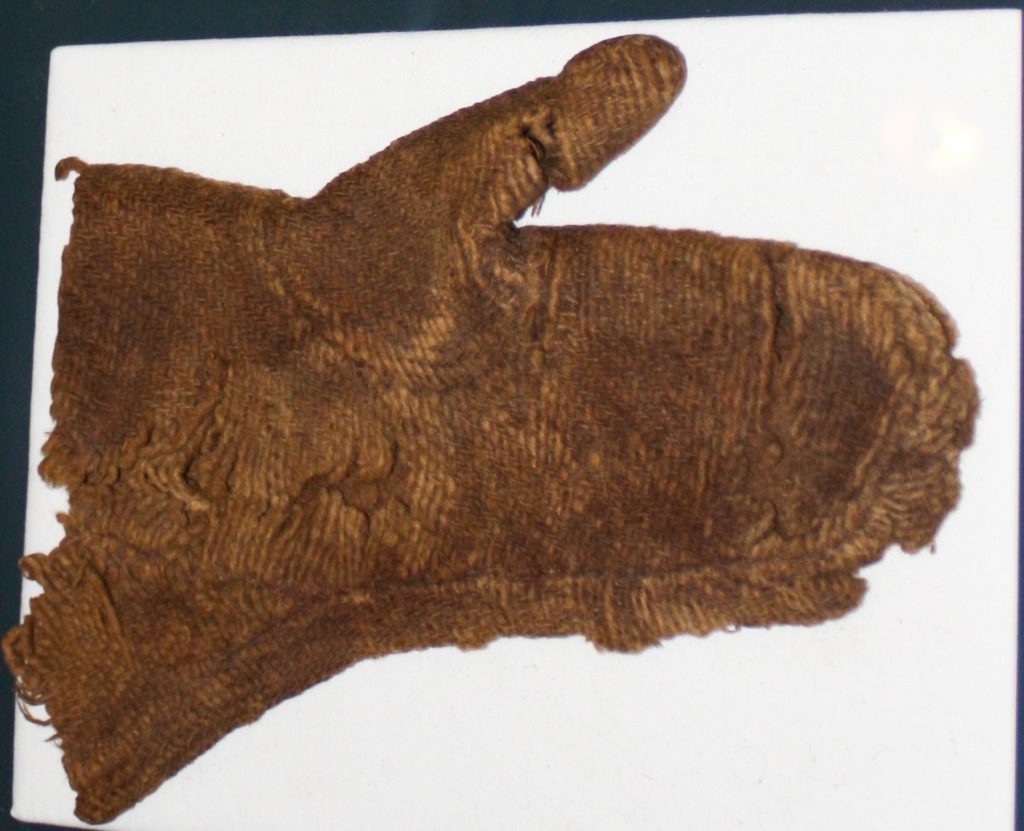












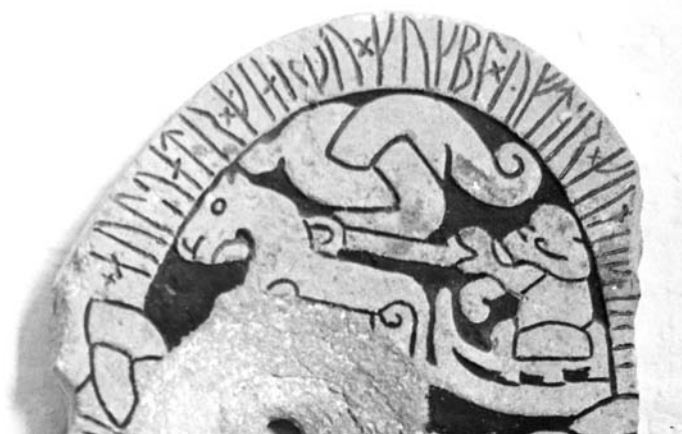
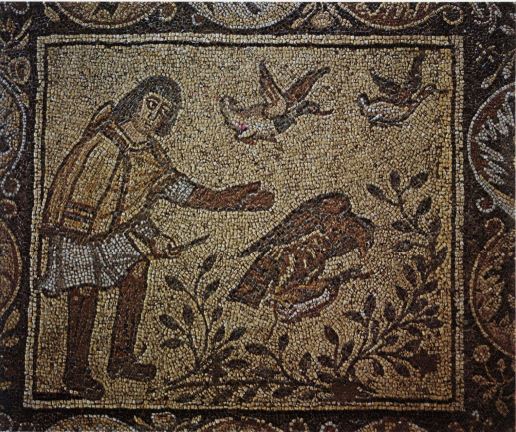

3 Responses
This is an excellent and well researched article David. A great resource for re enactors historians. I know of a glovers needle find, because of an inscription in Runes ‘skefningar’ which means glovers needle. It may have been used for naalbinding or sewing. Also there is a description of a mitten in one of the sagas. The Gods shelter in it on the way to Jotenheim, thinking it is a hall. Cheers from Russ
Thank you for this article. There is an interesting image included that seems to lack a source like the others. It’s the white glove with color on its knuckles. File name is moščevaja-balka-rukavice.jpg. Would you be able to let me know where that image comes from? I would like to see the article or book where it was published. Thanks.
Hello Ken, the source is there from the very beginning.